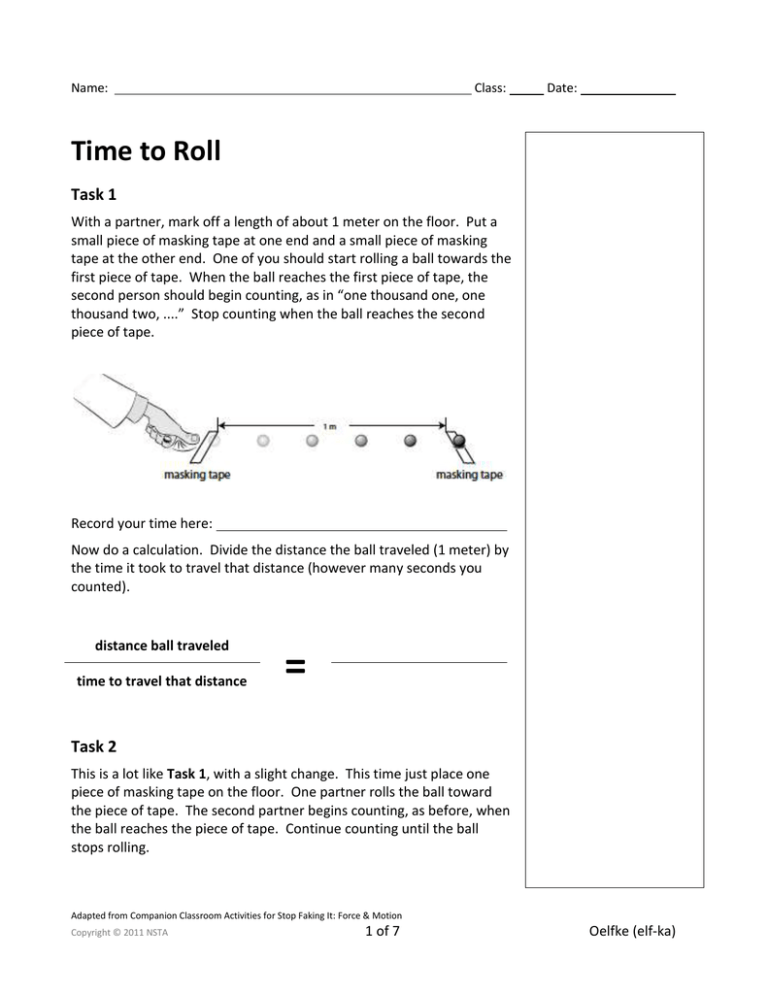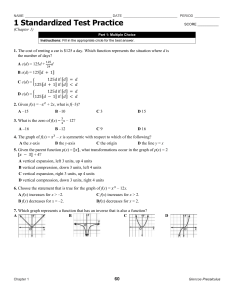Time to Roll
advertisement

Name: Class: Date: Time to Roll Task 1 With a partner, mark off a length of about 1 meter on the floor. Put a small piece of masking tape at one end and a small piece of masking tape at the other end. One of you should start rolling a ball towards the first piece of tape. When the ball reaches the first piece of tape, the second person should begin counting, as in “one thousand one, one thousand two, ....” Stop counting when the ball reaches the second piece of tape. Record your time here: Now do a calculation. Divide the distance the ball traveled (1 meter) by the time it took to travel that distance (however many seconds you counted). distance ball traveled time to travel that distance = Task 2 This is a lot like Task 1, with a slight change. This time just place one piece of masking tape on the floor. One partner rolls the ball toward the piece of tape. The second partner begins counting, as before, when the ball reaches the piece of tape. Continue counting until the ball stops rolling. Adapted from Companion Classroom Activities for Stop Faking It: Force & Motion Copyright © 2011 NSTA 1 of 7 Oelfke (elf-ka) Record your time here: Measure the total distance the ball traveled in meters. Record your distance here: Time for another calculation. Divide the distance the ball traveled (the distance you measured) by the time it took for the ball to travel that distance (however many seconds you counted). distance ball traveled time to travel that distance = Adapted from Companion Classroom Activities for Stop Faking It: Force & Motion Copyright © 2011 NSTA 2 of 7 Oelfke (elf-ka) Name: Class: Date: Describing Motion In the activity Time to Roll, you timed how long it took a ball to travel a couple of different distances. The first distance was 1 meter. The time it took your ball to travel one meter could have been anywhere from ¼ of a second to 2 seconds. It all depends on how fast you rolled the ball. After doing the timing, you divided the distance traveled (1 meter) by how long it took to travel that distance. In doing that calculation, you determined the ball’s speed. In fact, that’s how we define speed. = Speed distance an object travels time to travel that distance So, suppose it took your ball one second to travel one meter. Then you would calculate the speed as Speed of ball = distance an object travels time to travel that distance = 1 meter 1 second = m 1 s This can also be written as 1 m/s. If it took your ball 2 seconds to travel that one meter, then the speed of the ball would be Speed of ball = distance an object travels time to travel that distance = 1 meter 2 second = m 0.5 s This can also be written as 0.5 m/s. Notice that you don’t just use a number for the speed, such as 1, 2, 0.5, or 7. There are units attached to the number, in this case meters/second (stated “meters per second”). You’ve no doubt dealt with speeds before. Car speeds in the United States are measured in miles/hour rather than meters/second. In other countries, car speeds are measured in kilometers/hour. Whatever object you’re talking about, though, the units you measure speed in are a distance divided by a time. By comparing speeds, you can compare how fast or slow objects are moving. Clearly, a plane traveling at a speed of 500 Adapted from Companion Classroom Activities for Stop Faking It: Force & Motion Copyright © 2011 NSTA 3 of 7 Oelfke (elf-ka) miles/hour is moving a lot faster than a bicycle traveling at 20 miles/hour. Now, measuring speeds in different units can make comparisons difficult. Is a ball traveling at 1 meter/second traveling faster or slower than a car going down the street at 20 miles/hour? It’s not easy to tell without using the same units. We’re not going to spend time comparing speeds with different units right now. Just be aware that the units are important. You should always have units attached to things like speeds. If you say something is moving at a speed of 10, that doesn’t tell you much. That could be 10 kilometers/second (really fast!) or 10 meters/hour (really slow!). On Being Average After calculating the speed of the ball that traveled 1 meter, you did the same calculation for a ball that rolled to a stop. Chances are the speed you got in this second case was pretty close to the speed you got for the ball traveling 1 meter. So what’s up with that? Let’s say you got a speed of 1 meter/second in the situation where the ball rolled to a stop. Was the ball rolling at that speed the entire time? If not, when was the ball going that speed? At the beginning? At the end? Well, clearly not at the end, because at that point the ball was at rest, and its speed was 0 meters/second. And when the ball went by the first piece of tape, it was probably traveling faster than 1 meter/second. So what’s the meaning of that speed of 1 meter/second? The speed you calculated was the average speed of the ball during that entire time. At any particular time, the ball was traveling at a speed different from the average speed. If the average speed was 1 meter/ second, then the speed it was traveling at the start was probably something like 2 meters/second. Later maybe it was traveling at 1.5 meters/second. Just before it stopped, it might have been traveling at 0.2 meters/second. And when it stopped, it was traveling at 0 meters/second. See Figure 1. So, there are two kinds of speed. One is the average speed (the total distance traveled divided by the total time it took to travel that distance) and the other is the instantaneous speed (the speed something is traveling at a particular point in time). Adapted from Companion Classroom Activities for Stop Faking It: Force & Motion Copyright © 2011 NSTA 4 of 7 Oelfke (elf-ka) Let’s say you’re walking to school. You leave your house traveling at a speed of 0.5 meters/second and walk at that speed for 5 minutes (300 seconds). Then you stop and pet a neighbor’s dog for one minute (60 seconds). Then you continue on to school traveling at 1 meter per second (you had to speed up because you wasted time petting the dog). It takes you a total of 15 minutes (900 seconds) to get to school, and you travel a total of 1050 meters. What’s your average speed? Well, you just use the definition of average speed, which is distance ball traveled time to travel that distance Putting in the correct numbers, you get distance an object travels time to travel that distance = 1050 meter 1200 second = m 0.875 s This can also be written as 0.875 m/s. Of course, that average speed doesn’t give all the details of your motion. If you tell someone your average speed, they have no idea how fast you were traveling at any given time or whether or not you stopped to pet a dog. Average speed is easy to figure out. Just take the total distance something travels and divide by the time it takes to travel that distance. Instantaneous speed is not easy to figure out. You can’t just divide two numbers. But the idea of instantaneous speed isn’t so difficult. It’s just the speed you happen to be traveling at any particular time. Adapted from Companion Classroom Activities for Stop Faking It: Force & Motion Copyright © 2011 NSTA 5 of 7 Oelfke (elf-ka) Name: Class: Date: Different Speeds Answer the following questions as completely as possible. 1. What does the speedometer on a car measure: average speed or instantaneous speed? How do you know? 2. Waldo gets stopped by the police, and the policewoman tells Waldo that she caught him on radar doing 50 miles per hour in a 40-miles-per-hour zone. Waldo responds thusly: “No way I was traveling 50 miles per hour. I sat at home for 1 hour and then drove for 1 hour before you stopped me. I traveled 50 miles total in that second hour. So my speed was 25 miles per hour. That’s well under the speed limit.” Show how Waldo came up with a speed of 25 miles per hour. Then decide whether or not Waldo should get a speeding ticket and explain why. 3. Extra challenge: We haven’t discussed how to calculate instantaneous speeds. How do you think you might go about doing that? Adapted from Companion Classroom Activities for Stop Faking It: Force & Motion Copyright © 2011 NSTA 6 of 7 Oelfke (elf-ka) Name: Class: Date: Evaluation You are sitting by the side of a country road, and a car comes speeding along. Suddenly it stops in front of you for just a second, then speeds off again in the same direction, going faster and faster as it disappears from view. Which of the following is true regarding the car’s motion? 1. 2. 3. 4. Its instantaneous speed was never equal to zero. Its average speed is the same as its instantaneous speed. Its average speed during the motion was equal to zero. Its average speed was never equal to zero. Explain why you choose your answer. Adapted from Companion Classroom Activities for Stop Faking It: Force & Motion Copyright © 2011 NSTA 7 of 7 Oelfke (elf-ka)









